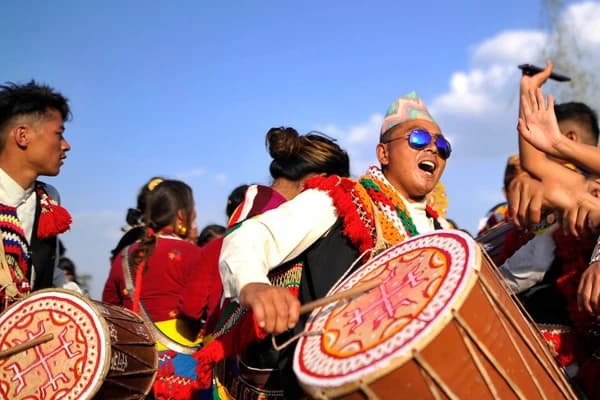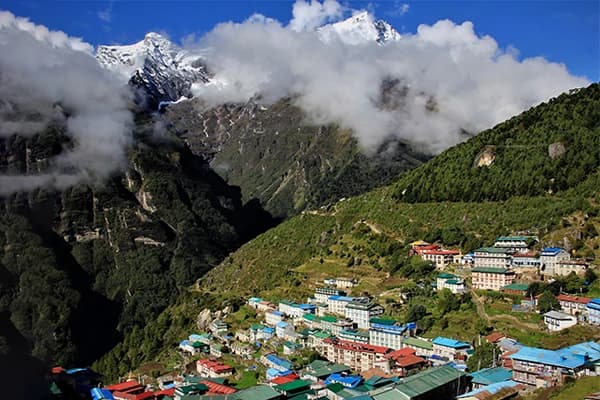The Symbolism of Saraswati Puja in Nepal
The symbolism of the Basant Panchami pooja in nepal is explained below.
- Saraswati goddess’s veena depicts her association with music; the book represents her association with knowledge, mala (rosary) represents spiritual enlightenment, discipline, and meditation, and the lotus represents purity.
- The use of yellow or white colored flowers symbolizes the knowledge and learning.
- The cultural programs featuring the music, dance and other performances honoring the goddess represent Saraswati's role as the goddess of arts.
Importance of Saraswati Puja
There is great importance of Saraswati Puja in Nepalese society. On this day, goddess Saraswati is worshipped. The goddess Saraswati is revered as the deity of wisdom and creativity. The devotees seek her blessing for the success in studies, artistic pursuits, and intellectual endeavors.
This festival also coincides with the arrival of spring. From this day, the winter is supposed to end and a new season is to begin. It symbolizes the rebirth and regeneration in Nature.
Furthermore, from this day, the children begin their educational journey through Akshar-Abhyasam rituals. In this ritual, the small children learn to write for the first time.
Rituals and Traditions of Saraswati Puja in Nepal
Like other festivals, dashain and tihar, the Saraswati Puja in Nepal is also done with rituals. There are certain traditions that have been followed from generation to generation on the Saraswati Puja. the important rituals and traditions of the worship are briefly described below.
- Preparations for the Puja
The primary step of the Saraswati puja 2025 is preparation for the puja. First of all, all the puja items are collected, including the idol or picture of goddess Saraswati, Kalas, flowers, incense sticks and lamp, vermillion, turmeric, rice, sweets, fruits, books, pens, bell, conch shell, white cloth, and so on.
The items are collected based on the program size. In the homes, all the above-mentioned things may not be collected for the puja. However, in the big ceremonies and events of Saraswati Puja, there are more materials collected in large amounts.
- Cleaning and setting up altars with Goddess Saraswati’s idol or image.
After the collection of all the materials, the puja are cleaned thoroughly. Then, the altar is set up on the table covered with the white cloth. After that, the idol or picture of the goddess Saraswati is placed at the center of the altar.
In the big institutions, the idol is used, while in the small households, the photo of the goddess is used. It does not matter what you are using but you have to pray with all your heart.
- Decorate with flowers, incense, and offerings.
When the altars with idols or images are set up, then the place is decorated with the flowers, incense and all the offerings. The offerings mostly include flowers, fruits, sweets, and books. The environment becomes so religious.
Garlands are created to adorn the image or idol. Flowers are scattered around the altar. The offerings are placed near the idol or image. Then, a rangoli design is created in front of the altar using rice flour or colored powder.
Then, a kalas filled with water is placed near the altar. All these decorations are connected with the purity and abundance. These are the traditional elements of Hindu puja. While choosing the flowers, always choose the yellow or white flowers, as they are associated with purity and knowledge.
- Prayers and mantras to Goddess Saraswati.
Prayers and mantras hold a special place in the Saraswati worship. During the puja, prayers and mantras are used to invoke the blessings of goddess Saraswati. The key prayers and mantras are Saraswati Vandana and the Saraswati puja mantra.
Saraswati Vandana is a devotional hymn that includes verses that describe goddess Saraswati’s divine attributes and invoke her presence.
The saraswati puja mantra is “Yaa brahmachyuta shankara prabhrutibhi devai sadaa vandita Saa maam pathu saraswati bhagavati nishshesha jadyapaha Aum saraswathyae namah dhyanartham pushpam samarpayami.”
- Special worship of books, musical instruments, and tools of learning.
During the Saraswati puja, a special worship is done. The worship is dedicated to books, musical instruments, and tools of learning. This worship is done to honor the goddess Saraswati.
The musical instruments, like the veena, are placed near the altar as an offering to the goddess. The tools of learning, like books, pens and other writing tools, are also placed near the altar to honor the goddess.
- Offering of sweets and other foods to the goddess.
The prepared sweets and other foods are offered to the goddess Saraswati; the offering is made with love and devotion. The food and offering offered to the god are described in the next topic.
Foods and Offerings During Saraswati Puja in Nepal
The food and offering is an important part of the Saraswati puja in Nepal 2025. Various traditional foods are prepared and offered to the goddess Saraswati, deity of knowledge, wisdom, music, and art.
The traditional foods and offerings offered during the puja of the goddess Saraswati are:
- Boondi Laddo: It is the people's favourite food made from gram flour. These sweet balls are common in all the offerings of the institutions or homes.
- Meethe Chawal: It is a sweet rice prepared with ghee, rice, nuts, saffron, and other ingredients.
- Barfi: It is a sweet made primarily from milk solids, sugar, and nuts.
- Khichuri: It is a savory porridge made from black lentils and rice, seasoned with spices and ghee.
- Kheer: It is a dessert made with saffron milk, sugar, broken rice, cardamom powder, and nuts.
- Panchamrit: it is a sacred prasad made by mixing milk with yogurt, ghee, honey, and sugar.
- Fruits: various fruits like carrots, apples, bananas, and so on are offered to the god and also distributed among the devotees.
- Khichdi: it is a savory rice preparation. Khichdi is also prepared during the Saraswati puja.
The other offerings are:
- Flowers and garlands: Yellow flowers like marigold are offered to the goddess Saraswati during prayers and puja.
How do artists and musicians celebrate the day?
The Saraswati Puja is an important day for the artists and musicians. They celebrate the day with various rituals, offerings and cultural performances. For example, the artists and musicians often place their tools and instruments at the feet of goddess Saraswati as an offering.
The devotees chant the mantras. It is believed that by doing so, the Saraswati goddess grants knowledge, creativity, and fluency. The flowers, like marigold and fruits, like apples and bananas, are offered to the god seeking blessing for the success of artistic journeys.
Furthermore, artists and musicians perform the devotional and classical songs to honor the goddess Saraswati. On the same occasion, the popular traditional dances like Bharatanatyam, Odissi, and Kathak are also performed.
Celebration of Saraswati Puja in Schools, Colleges, and Universities in Nepal
The Saraswati Puja celebration in schools and colleges differs from that of celebrations in universities. During the Shree Panchami puja, educational institutions are decorated with the colorful flowers and festoons. The stages are made featuring the statues of goddess Saraswati.
The students, teachers, and staff participate in prayers and ceremonies of Saraswati puja. During the prayer, students seek blessings for academic success and creativity. They offer the sweets, fruits, and flowers to the goddess.
Several institutions organize the poetry recitals and music events. students participate in the event. It helps students express themselves, develop emotional intelligence, learn how to read and understand text, learn a sense of unity, and so on.
Furthermore, the universities hold grand celebrations. Students, faculty members, and alumni participate in the prayers and cultural performances. The sacred offerings (prasad) are distributed among them. The Saraswati puja is seen as an opportunity for students to express gratitude for knowledge and seek guidance for their academic pursuits.
Involvement of Children in the puja for an educational experience
Involving the children in the Saraswati puja can be a good idea. It can provide the children an educational experience. Children can learn the spirituality in a fun and accessible manner. Home pujas are the best for the children as they will learn from their own comfort zone.
The activities like music and dance will boost confidence, help them learn their self-expression, and improve the self-esteem of the children.
It is very important to introduce the children to the diverse cultural practices from a young age. Celebrations like the Basant Panchami Puja enrich children’s knowledge of Nepalese culture. It will motivate them to respect the efforts behind every creation.
Tips for tourists attending the Saraswati puja in Nepal
- Understand the festival and respect the rituals, customs and people.
- While visiting the temple or sacred sites, remove your shoes.
- Take permission before taking photographs inside temples or sacred sites.
- Wear modest clothing and avoid public displays of affection.
- Participate in the recitation of hymns and lighting lamps, which is an important ritual of the Saraswati puja.
- Engage in cultural programs that include music, dance, and drama performances.
- Join local gatherings to experience the festive atmosphere and participate in communal prayers.
- Visit the popular temples like Swayambhunath (Monkey Temple) or Boudhanath Stupa, or you can book a one day kathmandu tour and visit the other sites too.
Conclusion
Saraswati Puja 2025 in Nepal is going to be celebrated with various rituals and prrogrammes. The festival is celebrated all over the nation in the educational institutions, universities and other places by the students, tutors, learners, artists, musicians and other people. Celebrated in February, this auspicious festival marks the end of winter and the start of the new season.





